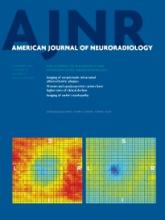We thank Dr Luiz Celso Hygino Cruz Jr for his interest in our review article1 on spinal cord MR spectroscopy, and we appreciate the presentation of his own spinal cord MR spectroscopy data acquired from a patient with a non-Hodgkin lymphoma. It is a good example of the feasibility and usefulness of MR spectroscopy in the spinal cord and demonstrates that additional information, which is complementary to other imaging methods, can be obtained. The presentation of these findings could help other clinical groups during the differentiation process in similar cases and may stimulate interest in using spinal cord MR spectroscopy in clinical routine. We also agree that the acquisition protocol can be simplified in comparison with our suggestions in the cited review article1 in this specific case.
However, the simplification of the acquisition protocol is not generally applicable but was enabled by the specific conditions in a case of a space-occupying lesion filling the spinal canal as reported by Dr Hygino da Cruz. The presented lesion is significantly larger compared with the normal diameter of a healthy or even atrophic spinal cord, thus a larger voxel size can be used. In Dr Cruz's article, the voxel size was 2 mL compared with approximately 1.2 mL in healthy spinal cord,2 which implies an SNR increase by a factor of approximately 1.7. To achieve the same SNR in a smaller spinal cord MR spectroscopy voxel from a healthy or atrophic spinal cord, an increase of at least a factor of 2.9 in scanning time is necessary. In addition, the space-occupying lesion hinders the CSF flow and thus reduces the need for flow- and motion-correction methods. The application at 1.5T in conjunction with a larger lesion also reduces susceptibility changes and thus lowers the requirements for B0 shimming methodology. Compared with 3T, measurements at 1.5T theoretically have a lower SNR. In practice, the SNR difference between 1.5T and 3T is not substantial,3 due to a better B0 homogeneity at 1.5T leading to a smaller absolute line width along with a more accurate flip angle calibration in the presence of a more homogeneous transmit B1 field and negligible chemical shift displacement artifacts at 1.5T.
Furthermore, some lesions show a dramatic increase of specific metabolite concentrations (eg, the presented case seems to exhibit an elevated Cho peak), which can be easily observed with a reduced SNR (unfortunately, the SNR value of the measurement was not reported). The particular situation (a space-occupying lesion versus a normal-diameter spinal cord) minimizes the technical challenges of MR spectroscopy and makes the simplified spinal cord MR spectroscopy protocol used by Dr Cruz and coworkers applicable to the reported case.
In conclusion, in some cases, especially when the voxel size can be increased (eg, in space-occupying lesions), a reduction of the scanning time is possible. However, a simplified and shortened MR spectroscopy protocol applied to measurements in other spinal cord conditions might lead to bad spectral quality and potentially erroneous conclusions. Therefore, an MR spectroscopy scan protocol leading to high-quality MR spectroscopy data across different spinal cord diseases is indispensable.
Nevertheless, we congratulate Dr Cruz for his report and are looking forward to seeing more detailed reports of spinal cord MR spectroscopy in various conditions, including quality indicators like SNR and line width.
- © 2013 by American Journal of Neuroradiology












